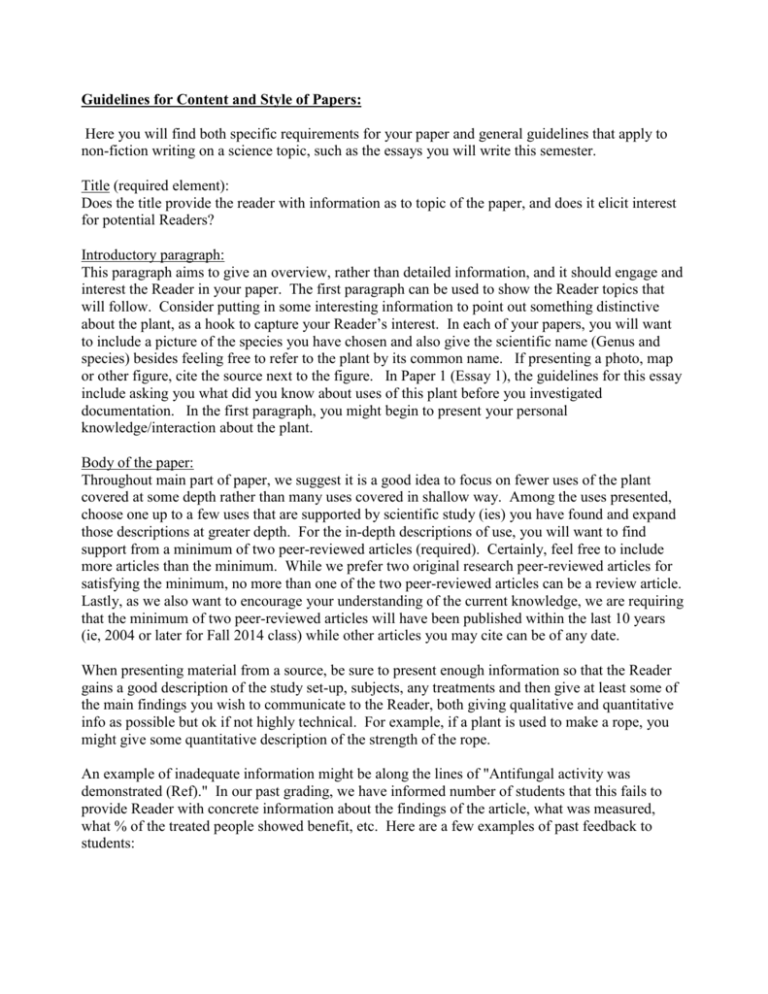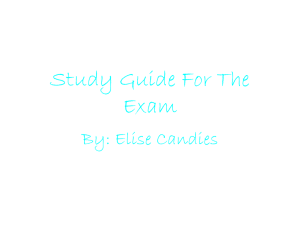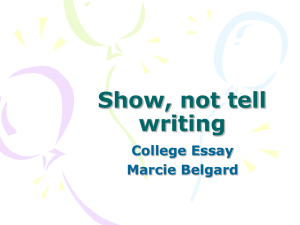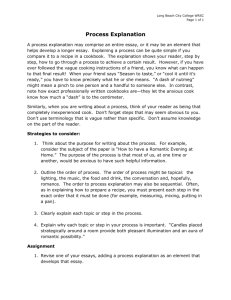guidelines-content_and_style
advertisement

Guidelines for Content and Style of Papers: Here you will find both specific requirements for your paper and general guidelines that apply to non-fiction writing on a science topic, such as the essays you will write this semester. Title (required element): Does the title provide the reader with information as to topic of the paper, and does it elicit interest for potential Readers? Introductory paragraph: This paragraph aims to give an overview, rather than detailed information, and it should engage and interest the Reader in your paper. The first paragraph can be used to show the Reader topics that will follow. Consider putting in some interesting information to point out something distinctive about the plant, as a hook to capture your Reader’s interest. In each of your papers, you will want to include a picture of the species you have chosen and also give the scientific name (Genus and species) besides feeling free to refer to the plant by its common name. If presenting a photo, map or other figure, cite the source next to the figure. In Paper 1 (Essay 1), the guidelines for this essay include asking you what did you know about uses of this plant before you investigated documentation. In the first paragraph, you might begin to present your personal knowledge/interaction about the plant. Body of the paper: Throughout main part of paper, we suggest it is a good idea to focus on fewer uses of the plant covered at some depth rather than many uses covered in shallow way. Among the uses presented, choose one up to a few uses that are supported by scientific study (ies) you have found and expand those descriptions at greater depth. For the in-depth descriptions of use, you will want to find support from a minimum of two peer-reviewed articles (required). Certainly, feel free to include more articles than the minimum. While we prefer two original research peer-reviewed articles for satisfying the minimum, no more than one of the two peer-reviewed articles can be a review article. Lastly, as we also want to encourage your understanding of the current knowledge, we are requiring that the minimum of two peer-reviewed articles will have been published within the last 10 years (ie, 2004 or later for Fall 2014 class) while other articles you may cite can be of any date. When presenting material from a source, be sure to present enough information so that the Reader gains a good description of the study set-up, subjects, any treatments and then give at least some of the main findings you wish to communicate to the Reader, both giving qualitative and quantitative info as possible but ok if not highly technical. For example, if a plant is used to make a rope, you might give some quantitative description of the strength of the rope. An example of inadequate information might be along the lines of "Antifungal activity was demonstrated (Ref)." In our past grading, we have informed number of students that this fails to provide Reader with concrete information about the findings of the article, what was measured, what % of the treated people showed benefit, etc. Here are a few examples of past feedback to students: -Can you give some quantitative description on how much better ________makes a given process or helps with a health condition? Not needed for all examples but good to include for a few that you cover at greater depth. - You appear to have found some good references giving evidence about uses, properties of ______ but Reader has no insight or confidence in those findings because they are not presented, distinct from the more personal experience, society traditional use part of your essay. Also, it is good to be critical of the source(s) to extent you can---was the study done well? Are there limitations to the study that narrows scope of findings? For example, a study in which 15 people were followed for the effects of herbal supplementation to the diet would not be as comprehensive as a study following a much larger population of people. As you are writing then editing your paper, evaluate and revise so that you are incorporating aspects of good writing such as: Succinct writing. This will open up room in the paper for other content. Look for redundancy in your sentences. Do you see some repeated information or repetitive use of words? Perhaps sentences are excessively wordy and you can write more briefly. Good organization and flow. We urge you to consider where you present material for the Reader and whether you have a good flow of your content, transitions between topics, good topic sentences for leading off paragraphs. For examples, here are some of our past feedbacks to student writers: -Does the Reader needs this material here given next sentence and further development in your essay? -Nice first paragraph. Just look at revising a bit on the flow. Can you see how to improve by minor rearrangement? -Wordiness, disjointed organization of topics -Poor or missing topic sentence, redundancy, run ons etc. A good tip from professional writers is to read your work out loud, can often catch problems in the writing. The writing needs to be your own writing, your own phrasing. This is extremely important. Please see Office of Student Judicial Services website and also UT Library websites for information on preparing material in your own words, definitions of plagiarism. Quoting from sources should be avoided, even giving clear attribution. In science based compositions, overwhelming precedent is to provide the information in your own words. In English or History etc papers, the writing itself in a source may be quoted so that you can use to provide your interpretation, commentary about it. However in science, you just want to get the info across and quotes are not customarily utilized for conveying scientific information (see for example the writing in various journal articles you’ve read in your bibliography) . Only very rarely, there may be some very out of the ordinary, clever way that someone said something and you may consider quoting it. Closing paragraph: Good to have a closing para for expanding Reader’s mind back out to general theme or take-home of the paper, rather than end paper on a specific factual point. Format Guidelines Please follow these Format Guidelines for your paper: o Double spaced; 1-inch margins all around. o Include your name and a title that both informs and elicits interest o 12 point size font, preferably Times, Times Roman, Helvetica or Arial. o Citation in main text of report: Cite last name of author(s), followed by a comma, then date of publication. For example: Rope samples contain cells from the plants of origin (Dunbar and Murphy, 2009). If there are more than two authors, then simply cite the last name of the first author, followed by et al. For example, if in your text you referred to a 2004 article by Henry McKenna, John Hearle and Nathan O’Hear, you would cite it in your text as: (McKenna et al., 2004) [Note: No initials, only last name] If citation is from a webpage, indicate this by writing enough of the web address to uniquely specify it, typically by writing the first word in the address after http://www. For example Another report gave details on the DNA analysis of rope fibre (http://www.wonderville) o Citation in Bibliography: >If from a scientific or popular journal: Dunbar M, Murphy T. 2009. DNA analysis of natural fiber rope. Journal of Forensic Sciences 54: 108-113. [Order: authors, date of publication, title of article, journal name (in italics), volume (in bold), page numbers. [N.B.: Only initial of 1st name, no period except after initial of last author listed before the year] >If from a book: McKenna HA, Hearle JSS, O'Hear N. 2004. Handbook of fibre rope technology. CRC Press, Boca Raton, FL. > If citation is from a webpage, cite the full webpage address. E.g.: http://www.wonderville.ca/v1/activities/scienceathome/fibre_analysis.pdf Weaknesses seen in several of the early papers last year: 1. Genus species Latin names should be italicized. The Latin names have two parts, Genus name and species name, and both are italicized. The first letter of the genus name should be capitalized, but typically the species name is not capitalized. 2. Use of wordy or gratuitous phrases: "It is known that…"; "….many people all over the world…"; …"from the beginning of time"…. 3. List of plant uses is given uncritically, with no proof of efficacy. " plant X used for w, x, y, z .." 4. Use of quotes rather than your own words. 5. Uncritical acceptance of every source, even popular gardening books…; no controversy, no alternative hypotheses. 6. Dry listing of plant attributes or characters with no discussion.









